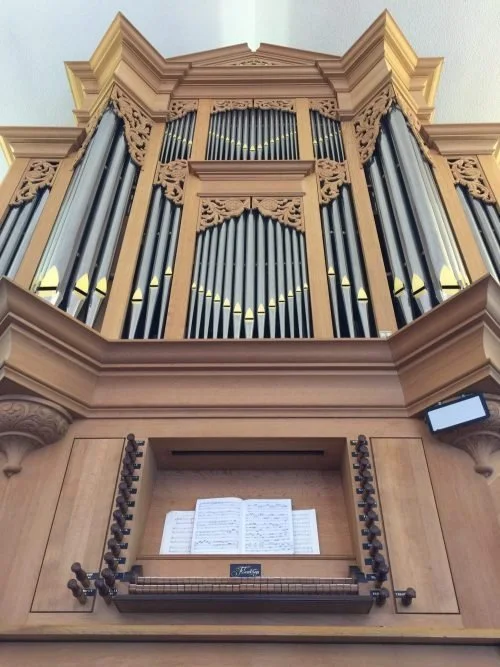The Flentrop Organ
The organ at Messiah Lutheran Church, Germantown, Maryland, was built in 1990 by the Flentrop Orgelbouw in Zaandam, Netherlands. It was dedicated on April 21, 1991.
Hendrik Wicher Flentrop established his organ building firm in the Netherlands in 1903. Dirk Andries Flentrop took over the company in 1940 and was succeeded by Antonio Johannes Steketee in 1976. Messiah’s instrument was built under Steketee’s direction.
This instrument has three keyboards, two manuals for the hands and one pedalboard for the feet, that are mechanically connected to 23 sets of pipes or registers and 30 ranks sounding at many pitch levels. The lower keyboard is the Hoofdwerk (Great), the upper keyboard the Bovenwerk (Swell), and the one for the feet the Pedal. The external case is made of French Oak, while some of the interior mechanical parts are cedar and mahogany. Most of the pipes on the instrument are made of a mixture of tin and lead. Two pedal ranks are constructed of mahogany.
The pipes contained in the casework are sounded through a series of mechanical levers, rollers, stickers, trackers, pallets and other devices that connect the keyboards with the sets of pipes. By depressing keys, the player causes these mechanical connections to let air, under pressure, flow into the pipes. Pipe organs have been built this way since they were invented more than two thousand years ago. The only use of electricity is to a blower that maintains a supply of compressed air and to illumination elements at the keydesk.
Many instruments manufactured in the 20th century use electricity to connect the player with the pipes, thus removing all limits on the size and location of an organ. The sound and purpose of instruments with electrical action is often very different from those that are purely mechanical. The Flentrop organ at Messiah Lutheran Church adheres to an older mechanical procedure of construction: The case of an organ is like the body of a violin, insofar as both structures focus and project the sound, as do the walls of the room in which the instrument is sounding. Organ cases tend to be works of art themselves, combining the techniques of woodcarving, cabinetmaking, and metalworking. An ideal placement location of an organ, both aurally and visually, is often in a balcony. The instrument at Messiah Lutheran Church is an excellent example of all these qualities.
FLENTROP 1990 organ specifications and stop list
23 registers, 30 ranks
HOOFDWERK l – (9 registers, 14 ranks)
Prestant 8
Gedekt 8
Octaaf 4
Roerfluit 4
Quint 3
Superoctaaf 2
Mixtuur IV 1 1/3
Cornet III 2 2/3 (partial-compass, C25-G56)
Trompet 8
BOVENWERK (Zwelwerk) II – (9 registers, 11 ranks) Enclosed behind swell shutters.
Bourdon 8
Gamba 8
Prestant 4
Fluit 4 (stopped)
Nasard 3
Woudfluit 2
Terts 1 3/5
Mixtuur III 2
Hoboi 8
PEDAAL – (5 registers, 5 ranks)
Bourdon 16 (wood)
Fluit 8 (open, wood)
Octaaf 4
Fagott 16
Trompet 8
Tremulant (whole organ)
Couplers (controlled by drawknobs)
Hoodfd+Boven / Boven+Hoodfd (reversible)
Hoofd+Pedaal
Boven+Pedaal


